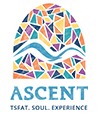by Yisrael Shalem
Rabbi Yosef Caro, born in 1488 in Spain, saw the great centers of Jewish learning in Europe systematically decimated and destroyed by expulsions, forced baptisms and inquisitions. By writing the Beit Yosef, Rabbi Caro sought to preserve Jewish scholarship and strengthen the unity of the Jewish people in the face of these hardships. This book, which took 32 years to write, cites opinions on halachic issues drawn from diverse traditions, and from them determines an authoritative interpretation of the law. A condensed version of the book, Shulchan Aruch (The Set Table), is one of the important books governing orthodox Jewish life today.
The Synagogue
The plaque above the entrance is a dedication to the man responsible for rebuilding the synagogue after the earthquake of 1837, Yitzchak Guetta. Guetta, an Italian Jew, was distressed to hear of the destruction caused by the earthquake in Safed. He resolved to rebuild the city and restored four of its synagogues. Like the Abuhav and Ari Ashkenazi synagogues, the Yosef Caro Synagogue has an imported Italian marble floor. Legend tells that Guetta used half of his budget in the reconstruction. The other half he buried, intending to complete the restoration when the messiah comes.
According to Jewish law, a synagogue’s entrance should be on the side far from Jerusalem, so that one enters already facing the direction of prayer (i.e. Safed’s synagogues should face south and be entered from the north). The entrance to this synagogue is on the wrong (south) side. Also, half of the floor is a step higher than the other half. The synagogue was built not as a house of worship but as a house of study – a beit midrash, which can be entered from any direction. The elevated side was used by the Sephardi rabbinic court on the occasions when the court convened in the beit midrash. In recent years the building was converted into a synagogue, a small women’s section added, and is in current use.
The Torah Scrolls.
There are three Torah scrolls in the ark. One is from Persia and is about 200 years old; one is from Iraq and is about 300 years old; and one is said to be from Spain and is over 500 years old.
The Windows.
According to halachah a synagogue’s windows should be near the top of the wall, with the heavens visible outside, to remind those inside of G-d. Also, if the windows are lower, people in the street might distract the congregation. Rabbi Avraham-Yitzchak Kook, the first Chief Ashkenazi Rabbi of Israel, explained that the purpose of the windows is to bring to mind the people outside, and that prayer should also bring one close to mankind.
~~~~~~~~~~~~~~~~~~~
Buy books about Safed and the ancient masters of Kabbalah at the Kabbala Online Shop.
abridged from: Safed: Six Self-Guided Tours, by Yisrael Shalem of blessed memory.
This book is available from Ascent, Box 296, Safed, Israel; email: ascent@AscentOfSafed.com
